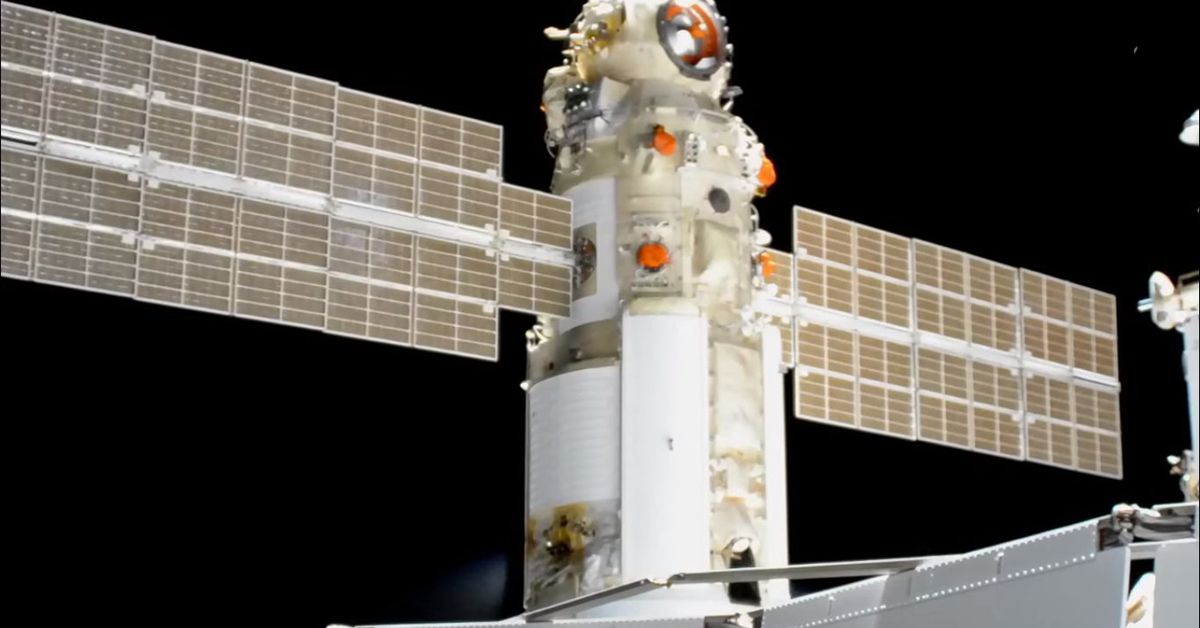Flight controllers have regained control of the International Space Station (ISS) after it was knocked off course by a newly arrived Russian research module.
Thursday’s mishap saw the jet thrusters of the multipurpose Nauka module inadvertently fire about three hours after it had latched on to the orbiting outpost, briefly throwing it out of control, officials with the United States space agency NASA said.
It took place as mission controllers in Moscow were performing some post-docking “reconfiguration” procedures, according to NASA.
The module’s jets inexplicably restarted, causing the entire ISS to pitch out of its normal flight position some 400km (250 miles) above the Earth. In response, the mission’s flight director declared a “spacecraft emergency”, NASA officials said.
But the seven crew members on board – two Russian cosmonauts, three NASA astronauts, a Japanese astronaut and a European Space Agency astronaut from France – were never in any immediate danger, according to NASA.
‘Tug of war’
An unexpected drift in the station’s orientation was first detected by automated ground sensors, followed 15 minutes later by a “loss of attitude control” that lasted a little more than 45 minutes, Joel Montalbano, manager of NASA’s space station programme, told reporters.
Flight teams on the ground managed to restore the ISS’s orientation by activating thrusters on another module of the orbiting platform, NASA officials said.
In its broadcast coverage of the incident, Russia’s RIA news agency cited NASA specialists at the Johnson Space Center in Houston, Texas, as describing the struggle to regain control of the space station as a “tug of war” between the two modules.
The station’s positioning is key for getting power from solar panels and communications.
At the height of the incident, the ISS was pitching out of alignment at the rate of about a half a degree per second, Montalbano said.
The Nauka engines were ultimately switched off, the space station was stabilised and its orientation was restored to where it had begun.
Communication with the crew was lost for several minutes twice during the disruption, Montalbano said, but those on board “really didn’t feel any movement”.
Had the situation become so dangerous as to require the evacuation of personnel, the crew could have escaped in a SpaceX crew capsule still parked at the outpost and designed to serve as a “lifeboat” if necessary, said Steve Stich, manager of NASA’s commercial crew programme.
Montalbano said there was no immediate sign of any damage to the space station following the incident. The flight correction manoeuvres used up more propellant reserves than desired, “but nothing I would worry about”, he said.
Series of glitches
Roscosmos attributed Thursday’s post-docking issue to a “short-term software failure”.
Vladimir Solovyov, flight director of the space station’s Russian segment, said in a statement on Friday that because of the failure, a direct command to turn on the lab’s engines was mistakenly implemented.
He added that the incident was “quickly countered by the propulsion system” of another Russian component at the station and “at the moment, the station is in its normal orientation” and all its systems “are operating normally.”
Roscosmos said checks on Nauka’s engines were being completed remotely by Russian specialists to ensure everyone’s safety and that the ISS was on its normal flight trajectory.
It said that the docking had been successful in so far as the seal between the new module and the rest of the ISS was hermetic.
Russian cosmonaut Oleg Novitsky meanwhile offered reassurance that Thursday’s incident had been dealt with.
“Don’t worry! Our work at the International Space Station to integrate the newly arrived Nauka module continues!” he tweeted. “Tonight we are going to open the hatches. Will keep you posted!”
After its launch last week from Kazakhstan’s Baikonur Cosmodrome, the 22-tonne Nauka module, named after the Russian word for “science”, experienced a series of glitches that raised concern about whether the docking procedure would go smoothly.
Its launch had previously been repeatedly delayed because of technical problems. It was initially scheduled to go up in 2007.
The Nauka module is designed to serve as a research lab, storage unit and airlock that will upgrade Russia’s capabilities on board the ISS.
It is the first new compartment for the Russian segment of the station since 2010. On Monday, one of the older Russian units, the Pirs spacewalking compartment, undocked from the space station to free up room for the new lab.
Nauka will require many manoeuvres, including up to 11 spacewalks beginning in early September, to prepare it for operation.
The malfunction prompted NASA to postpone until at least August 3 its planned launch of Boeing’s new CST-100 Starliner capsule on a highly anticipated uncrewed test flight to the space station.
The Starliner had been set to blast off atop an Atlas V rocket on Friday from the Kennedy Space Center in Florida.
Adblock test (Why?)
https://news.google.com/__i/rss/rd/articles/CBMiZ2h0dHBzOi8vd3d3LmFsamF6ZWVyYS5jb20vbmV3cy8yMDIxLzcvMzAvcnVzc2lhbi1zcGFjZS1tb2R1bGUtbWlzZmlyZS1taXNoYXAta25vY2tzLWlzcy1vdXQtb2YtcG9zaXRpb27SAWtodHRwczovL3d3dy5hbGphemVlcmEuY29tL2FtcC9uZXdzLzIwMjEvNy8zMC9ydXNzaWFuLXNwYWNlLW1vZHVsZS1taXNmaXJlLW1pc2hhcC1rbm9ja3MtaXNzLW91dC1vZi1wb3NpdGlvbg?oc=5
2021-07-30 11:08:00Z
52781761684896














